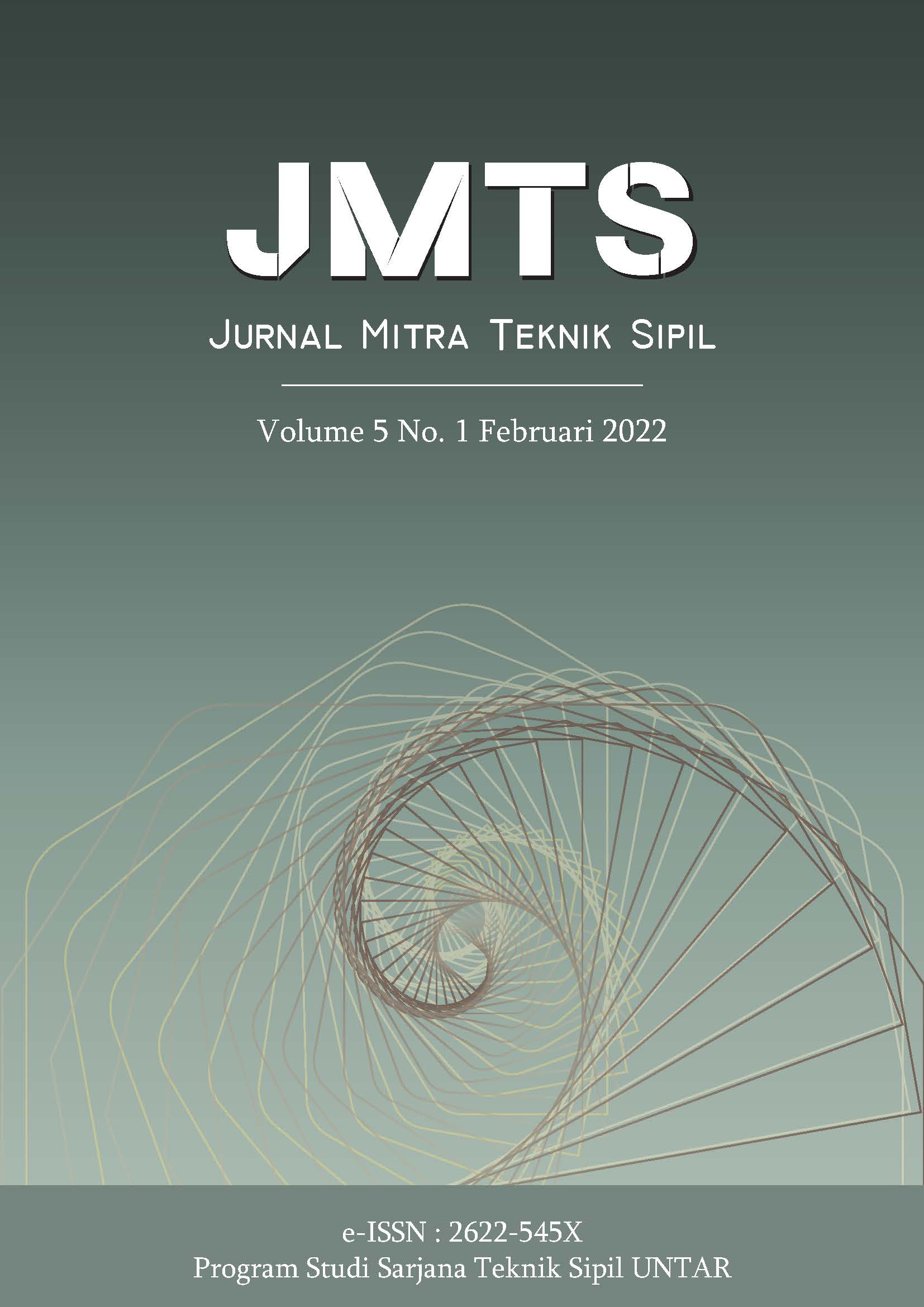PERINGKAT FAKTOR-FAKTOR YANG MEMPENGARUHI PRODUKTIVITAS KONSTRUKSI AKIBAT PENYEBARAN VIRUS COVID-19
Main Article Content
Abstract
A construction project is a series of activities as a way to complete an object requested by the owner by optimally utilizing the available resources. Increased productivity in a construction project is also one of the indicators that the project is achieving success, both for the provider and the service provider. However, the spread of the COVID-19 virus in Indonesia, especially the Jabodetabek area which also attacks the construction sector, has caused the productivity of project performance to decrease. Therefore, it is necessary to identify what factors affect construction productivity due to the spread of the COVID-19 virus. Data was collected through a literature study and followed by a survey using a Likert scale questionnaire to service providers in the project. A Likert scale of 1-5 and Relative Importance Index (RII) method are being used to arrange ranking of factors that affect construction productivity due to the spread of the COVID-19 virus. The results of the calculation of the relative importance index (RII) show that the availability of materials and equipment is ranked first with an RII value of 0,96 and the labor availability factor remains in the last rank with an RII value of 0,745.
Proyek konstruksi merupakan serangkaian kegiatan yang dilaksanakan sebagai cara untuk menyelesaikan suatu objek yang diminta oleh pemilik dengan memanfaatkan secara optimal sumber daya yang tersedia. Peningkatan produktivitas dalam proyek konstruksi ikut menjadi salah satu indikator yang menandakan bahwa proyek tersebut mencapai kesuksesannya, baik bagi pihak penyedia maupun pemberi jasa. Namun, adanya persebaran virus COVID-19 di Indonesia khususnya wilayah Jabodetabek yang juga menyerang bidang konstruksi menyebabkan produktivitas kinerja proyek menjadi menurun. Oleh sebab itu, perlu adanya identifikasi mengenai faktor-faktor apa saja yang mempengaruhi produktivitas konstruksi akibat penyebaran virus COVID-19. Data dikumpulkan melalui studi literatur dan dilanjutkan dengan survei yang menggunakan kuesioner berbentuk skala likert kepada para penyedia jasa di proyek. Skala likert berskala 1-5 digunakan dalam mengukur tingkat pengaruh suatu faktor dan dengan metode Relative Importance Index (RII), peringkat dari faktor-faktor yang mempengaruhi produktivitas konstruksi akibat penyebaran virus COVID-19 dapat tersusun. Hasil perhitungan indeks kepentingan relatif (RII) menunjukkan bahwa faktor ketersediaan material dan peralatan menduduki peringkat pertama dengan nilai RII sebesar 0,96 dan faktor ketersediaan tenaga kerja tetap berada di peringkat terakhir dengan nilai RII sebesar 0,745.
Article Details
References
Allmon, E., Haas, C. T., Borcherding, J. D., & Goodrum, P. M. (2000). U.S. Construction Labor Productivity Trends, 1970–1998. Journal of Construction Engineering and Management, 126(2), 97-104.
Alsharef, A., Banerjee, S., Uddin, S. J., Albert, A., & Jaselskis, E. (2021). Early Impacts of the COVID-19 Pandemic on the United States Construction Industry. International Journal of Environmental Research and Public Health, 18(4).
Cha, H. S., & Kim, K. C. (2011). Quantitative Approach for Project Performance Measurement on Building Construction in South Korea. KSCE Journal of Civil Engineering, 10.
El-Gohary, K. M., & Aziz, R. F. (2014). Factors Influencing Construction Labor Productivity in Egypt. Journal of Management in Engineering, 30(1), 1-9.
Hair, J. F. (2006). Multivariate Data Analysis. Pearson Prentice Hall.
Hasan, A., Baroudi, B., Elmualim, A., & Rameezdeen, R. (2018). Factors affecting construction productivity: a 30 year systematic review. Engineering, Construction and Architectural Management, 25(7), 916-937.
Holt, G. D. (2014). Asking questions, analysing answers: relative importance revisited. Construction Innovation, 14(1), 2-16.
Jarkas, A. M., & Bitar, C. G. (2012). Factors Affecting Construction Labor Productivity in Kuwait. Journal of Construction Engineering and Management, 138(7), 811-820.
Permono, S. L., & Mulyono, A. T. (2006). Analisis Pengaruh Penempatan Tenaga Kerja Serta Ketersediaan Material dan Peralatan Konstruksi Terhadap Capaian Mutu Jalan (Studi Kasus: Jalan Nasional D.I.Yogyakarta). Jurnal Media Komunikasi Teknik Sipil, 1-9.
Raditya, M., & Nazzario, G. (2020). Faktor-Faktor yang Memberikan Implikasi Terhadap Keterikatan Pekerja. Jurnal Riset Manajemen dan Bisnis (JRMB), 5(2), 61-72.
Rashid, H. (2015). Construction Management: A Professional Approach of Factors Affecting the Labor Productivity. International Journal of Engineering and Technical Research (IJETR), 3(3), 283-287.
Robles, G., Stifi, A., Ponz-Tienda, J., & Gentes, S. (2014). Labor Productivity in the Construction Industry-Factors Influencing the Spanish Construction Labor Productivity. International Journal of Civil and Environmental Engineering, 1061-1070.
Rooshdi, R. R., Majid, M. Z., Sahamir, S. R., & Ismail, N. A. (2018). Relative Importance Index of Sustainable Design and Construction Activities Criteria for Green Highway. Chemical Engineering Transactions, 63, 151-156.
Snyman, T., & Smallwood, J. (2017). Improving Productivity in the Business of Construction. Procedia Engineering, 182, 651-657.
Sugiyono. (2017). Metode Penelitian Kuantitatif, Kualitatif, dan R&D. Bandung: Alfabeta.
Wang, X., Chen, Y., Liu, B., Shen, Y., & Sun, H. (2013). A total factor productivity measure for the construction industry and analysis of its spatial diference: a case study in China. Construction Management and Economics, 31(10), 1059-1071.



